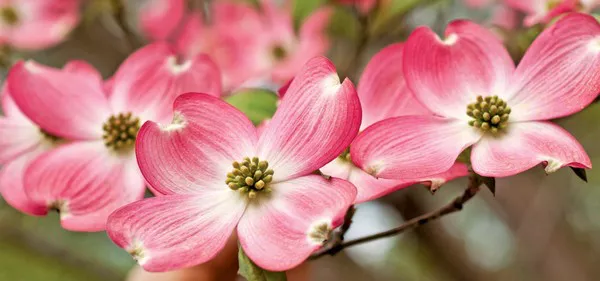In the world of flora, few blossoms carry the depth of symbolism and history as the dogwood flower. With its delicate petals and striking appearance, the dogwood has captivated cultures for centuries, weaving itself into folklore, religious narratives, and even modern-day landscapes. In this exploration, we delve into the rich tapestry of meanings behind the dogwood flower, uncovering its significance across time and geography.
A Brief Botanical Overview
Before delving into its symbolism, it’s essential to understand the botanical characteristics of the dogwood flower. Dogwood trees belong to the genus Cornus and encompass a variety of species, including the flowering dogwood (Cornus florida), the Pacific dogwood (Cornus nuttallii), and the Kousa dogwood (Cornus kousa). These trees are renowned for their ornamental value, producing clusters of small, four-petaled flowers in shades ranging from white to pink to red.
Native to North America, Europe, and Asia, dogwoods thrive in temperate regions, often gracing woodlands, gardens, and parks with their elegant presence. Beyond their aesthetic appeal, these trees play a vital ecological role, providing food and shelter for various wildlife species.
Historical and Cultural Significance
The symbolism of the dogwood flower traces back to ancient civilizations, where it was revered for its beauty and perceived spiritual qualities. In Native American cultures, the dogwood held multifaceted symbolism, representing rebirth, protection, and the interconnectedness of all living beings. Tribes such as the Cherokee and the Iroquois incorporated the dogwood into rituals and ceremonies, honoring its role in the natural world.
In European folklore, the dogwood acquired additional layers of meaning, often associated with themes of sacrifice, renewal, and divine intervention. According to Christian tradition, the dogwood flower bears a poignant symbolism linked to the crucifixion of Jesus Christ. Legend has it that the dogwood tree was once tall and sturdy, used to construct the cross on which Jesus was crucified. In response to this solemn role, the tree was cursed to never grow tall again, its blossoms marked with the shape of a cross and stained with the blood of Christ, symbolized by their reddish spots.
Symbolism Across Different Cultures
The symbolism of the dogwood flower transcends geographical boundaries, manifesting in diverse cultural contexts around the world. In Japan, for example, the dogwood (known as “Hanamizuki”) symbolizes endurance and resilience in the face of adversity. The Japanese admire the tree’s ability to flourish in harsh conditions, viewing it as a metaphor for human strength and perseverance.
Similarly, in Chinese culture, the dogwood holds symbolic significance as a harbinger of good fortune and prosperity. The tree’s vibrant blooms are celebrated during festivals and ceremonies, signifying abundance and auspicious beginnings.
In Celtic mythology, the dogwood is associated with the concept of protection and boundary-setting. The Celtic people believed that planting dogwood trees around their homes would ward off evil spirits and bring blessings to their families. This notion of protection extended to the spiritual realm, with the dogwood serving as a symbol of guidance and guardianship on the journey of life.
Modern Interpretations and Applications
In contemporary society, the symbolism of the dogwood flower continues to resonate, albeit in evolving ways. Beyond its traditional associations with religion and folklore, the dogwood has found new significance in various domains, including art, literature, and environmental conservation.
Artists and writers often draw inspiration from the graceful form and timeless beauty of the dogwood flower, incorporating its imagery into paintings, poetry, and other creative works. From Vincent van Gogh’s vibrant canvases to Tennessee Williams’ poetic prose, the dogwood has left an indelible mark on the cultural landscape, inspiring generations of creators.
In the realm of environmentalism, the dogwood’s symbolic value intersects with efforts to preserve and protect natural habitats. Conservation organizations leverage the iconic status of the dogwood to raise awareness about the importance of biodiversity and ecosystem conservation. By highlighting the beauty and fragility of species like the dogwood, activists advocate for sustainable practices and policies that safeguard the planet for future generations.
Personal and Emotional Significance
On a personal level, the symbolism of the dogwood flower often resonates deeply with individuals, evoking emotions of hope, resilience, and spiritual connection. Whether as a reminder of loved ones lost, a symbol of personal growth, or simply an appreciation for nature’s beauty, the dogwood holds a special place in the hearts of many.
For some, planting a dogwood tree in their garden becomes a meaningful act, symbolizing new beginnings and the cyclical nature of life. Watching the tree bloom each spring serves as a poignant reminder of the passage of time and the enduring power of nature’s cycles.
In times of adversity or uncertainty, the sight of a dogwood flower can offer solace and inspiration, reminding us of our capacity for resilience and renewal. Like the tree itself, we bend but do not break, finding strength in our roots and the connections that sustain us.
Conclusion
In conclusion, the symbolism of the dogwood flower encompasses a rich tapestry of meanings, spanning centuries and cultures with its timeless allure. From ancient myths to modern interpretations, the dogwood continues to captivate hearts and minds, serving as a potent symbol of beauty, resilience, and spiritual significance.
As we navigate the complexities of the modern world, may we draw inspiration from the elegance and symbolism of the dogwood flower, finding comfort and strength in its enduring presence. In honoring the legacy of this iconic blossom, we celebrate not only the beauty of nature but also the profound connections that unite us all in the intricate web of life.


